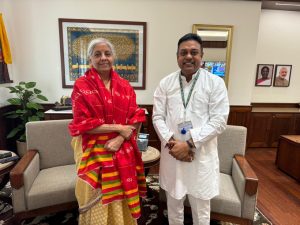‘Constitution is federal only in structure, not in spirit’

Image credit X @rajbhavan_tn
Constitution favours Centre over States to shadow federalism
By R. Narayanan
During 1970s, we may recall, the popular slogan among the politicians was socialism. If you do not support socialism, you are anti-poor and pro rich.
During 1980s, Mandal took over the space with the reservation of jobs for socially and educationally backward classes. Then came ‘Secular Policy’, which went to the extent of secularism being declared as basic structure by the Supreme Court.
Today, the main space has been occupied by federalism. Every political leader when he is in opposition speaks about the need for federalism. The same leader, when he becomes part of ruling dispensation, never opens his mouth.
It is, therefore, time for us to understand whether our Constitution envisages really federal principles.
The Constitution, adopted in November 1949, has the provisions tilted towards the Union only. Nothing except one provision was added to the Constitution, to make it biased in favour of the Union, after the it became effective.
First of all, nowhere in the Constitution, the term ‘Federation’ has been used. Article 1 says that India, i.e., Bharat is Union of States – neither United nor Federal nor Confederation.
Also read: US faces ‘Gaza Spring’ in varsity campuses ahead of Prez poll
A State is admitted in to the Union only on the conditions, prescribed by Parliament. No State can claim any equality nor can it secede from the Union, after joining.
The Division of powers, a characteristic of Federation, given in VII Schedule is tilted towards the Union – the Union list has 97 subjects, State list 61 and Concurrent list 52.
In fact, Federal Constitution cannot have any provision of Concurrent List. Both Parliament and State Legislatures can legislate on a concurrent subject.
However, in case of clash between the two, the Union law will prevail over the State Law unless the State Law was reserved for consideration by President and assented to by him.
Also read: Media as amplifiers during elections amid deepening disconnect
Any subject not included in any of the three lists, otherwise called Residuary Subject belongs to the Union and again not a Federal Principle. Thus, VII schedule ensures Federal Supremacy only.
Constitution empowers Parliament to legislate on State Subjects under some special circumstances. Under Art 249, on the strength of Rajya Sabha resolution being passed by 2/3rd majority and in national interest.
Under Art 252, when two or more State Legislatures pass a supportive resolution, asking the Parliament to make a law on a State subject.
This law passed by the Parliament can be adopted by any other State, after passing similar resolution. Under Article 250, when National Emergency, under Article 352 is promulgated, all State Subjects become Concurrent subjects.
Also read: Debating turning points of Indian politics amid Lok Sabha elections
Under Article 248, all residuary subjects belong to the Union, unlike Federal Constitution. Under Article 253, for implementing any treaty or international agreement, Parliament can make law on any State subject.
In respect of a State, under President Rule (Art 356), Parliament can make law on any subject. In respect of Union Territories, Parliament can make law on all subjects including State subjects.
Centre, in addition, exercises control over State Legislations through its representative viz. Governor. Under Art 200, the Governor can reserve any Bill for consideration of President who enjoys absolute Veto on all such Bills.
Governor cannot issue any ordinance without taking instructions from President in certain cases Under Article 213. A State Bill imposing reasonable restrictions on the freedom of trade and commerce can be introduced in the State Legislature only with the prior sanction of President under Article 304.
Also read: Stock Market: Bulls serve 330-volt shock to bears to raise Nifty above 22k
Union can direct the States to reserve all money bills and financial bills, passed by the State Legislatures for consideration of President during Financial Emergency under Article 360. Thus, the Constitution has assigned a position of Federal Supremacy in the sphere of State Legislations.
Unlike in other Federations, Indian States do not enjoy any territorial integrity. Under Article 3 & 4, Constitution empowers Parliament to create a State or bifurcate or reorganise or change the name of the State or its territory or its boundary, by passing an ordinary law by simple majority.
Simple majority is, subject to quorum, number of members present divided by two plus one. The only safe guard is that the Bill, before being introduced in either House should be recommended for introduction by President, who before such recommendation, is required to refer the Bill to the affected State Legislatures for their views.
The views, so expressed by the State Legislatures are not binding on the President. In other words, even if the States oppose the views, even then President is not bound by such views and he can recommend the introduction of the Bill.
Also read: Book Review: Mystical glimpses from world of sixty-four Yoginis
Most importantly, the satisfaction of the President is satisfaction of council of ministers since, under Article 74, President cannot act without the advice of Council of Ministers nor can he act contrary to such advice.
Ironically, even though the said law amends Schedule 1 (Union and Territories) and Schedule 4 (Reservation of Seats in Rajya Sabha), these changes are not treated as amendments for the purpose of Article 368.
Constitution does not speak about abolition of the State. Nevertheless, by implication, Parliament has the powers for merger of the States or Conversion of the UTs into States.
Without abolishing the State/UT, a new State cannot be created. In fact, there are many UTs which were converted in to State. But a State was never converted into a UT. However, in Aug 2019, for the first time, a State – J&K — was divided into two UTs – J&K with State Legislature and Ladakh without Legislature.
Apex Court upheld the action of the Union, of course, with a rider that the Statehood should be restored to J&K before Sept 2024.
In addition, we have Rajya Sabha comprising representatives of the States, an important pre-requisite of a Federation. However, constitution provides non-Federal feature of nomination of twelve members to Rajya Sabha.
Also read: Kota Coaching killing fields need parents to take call of empathy
How can there be nomination by President (Council of Ministers) for a Federal Chamber. Similarly, there is no equality for the States in the representation in Rajya Sabha – Sikkim has got 1 member while UP has 31 members.
All the above provisions are found in the original Constitution. There were 14 major committees constituted by Constituent Assembly to examine various provisions.
Drafting Committee was headed by Dr. Ambedkar, Provincial Committee by Sardar Patel so also State Committee. Another Committee was headed by Jawahar Lal Nehru to deal with the States.
So, all the above unitary features had been approved by the framers of the constitution. None of these was added in the Constitution through any amendment by any Government right from 1950.
So, if the States intend to have truly federal provisions in our constitution, the initiative should come from them and there is no use of blaming the past or present because they were part of the past and present.
(Opinion expressed in the article solely belongs to the author)








